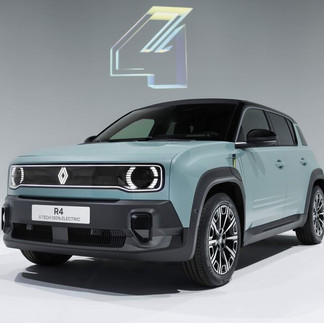
Renault has just recalled its idols of the past by bringing them up to date: the R4 and the R5 in electric versions. Renault is thus showing its vision of the future through electricity, yet the idea of having an electric R4 & R5 was already a reality of the past. A look back at history!

The R4: from petrol to electric
The R4 and the 4L for its "Luxury" version had a long career that lasted from 1961 to 1992 in France and 1995 in Morocco. This popular and versatile little car, nicknamed by its designers the "blue-jean car", will be produced in 28 countries and in all forms, from limousine to van, from thermal engine to electric.
In April 1971, for its 25th anniversary, EDF (Électricité De France) presented to the President of the French Republic, Georges Pompidou, a Renault 4 transformed into an electric vehicle by the Renardières research center. This initiative marked the beginning of EDF's involvement in electromobility. The transformation took 6 months, and involved major technical challenges, including the integration of the batteries and the connection of the electric motor to the wheels. The first tests were laborious, with problems of weight and mass distribution. However, after several adjustments, the engineers came up with viable solutions.
Equipped with lead batteries installed in place of the rear bench seat, it displayed performances that are now outdated for a private car. Its maximum speed was capped at 60 km/h, for ranges of 100-110 km on the road and 60-70 km in the city, obtained at lower speeds and in ideal conditions (no wind, rain, cold, or hills, and a very light foot on the accelerator). Although the line of the R4 is immediately recognizable, the bodywork is nevertheless very different, made with plastic materials. One detail betrays this special treatment: there is no side door at the rear. Except for the windshield, the windows were made of plexiglass, lighter than glass.
"The simplest use is use during the day and recharge at night", which explains why this model will not be emulated... until 2024 when Renault presents the new electric R4 e-tech, this time if a version marketed (at 30,000 euros) in 2024, and which takes its DNA from the past while keeping its principle of volume and versatility, it will be SUV and popular.
The R5 is even more electric
After the presentation of the electric R4 in 1974, Renault did it again with the collaboration with EDF, with the production of a small series of electric R5, the other best seller of the brand. It should be noted that between these two dates, in 1973 the oil crisis forced manufacturers and states to seek and develop more new energy solutions. The French government pushed its companies to develop their collaborations. It is therefore on the new best-selling car in France, the R5, which will have this task.
A hundred electric R5s sold for 18,000 francs with 48 V lead batteries (eight in total) were not very ecological, they were above all heavy and bulky. Indeed, the car had an empty weight of 1,020 kg, which was significant for the time. And their installation behind the driver's seat had required the removal of the rear bench seat. The electric R5 was therefore a two-seater car.
The other special feature of this electric Renault 5 was its sunroof at the rear. The advantage was that it was possible to change the batteries using a crane. Inside, there was no more gear lever, just two pedals on the floor: one for the brake, the other for the accelerator and no clutch pedal, because the electric motor no longer has a gearbox. Also gone were the fuel gauge and the oil pressure indicator.
For Renault and EDF: "The energy that electric vehicles consume, coming from EDF power stations, will, in the future, be mainly of nuclear origin, which will reduce the Nation's needs for petroleum products."
In 1974, Robert Poujade, then Minister of the Environment, visited the Renault factory in Lardy. He had the opportunity to drive the electric R5. A car that was already seen at the time as the solution to pollution problems.

A few years were enough to achieve better performance than the R4: maximum speed of around 80 km/h, full recharge in around ten hours, up to 175 kilometres of autonomy in the best conditions.
However, the revival of the electric R5 e-tech will take place just before that of the electric R4 e-tech and will be listed just below the R4 e-tech (considered more luxurious).
But this is only the beginning of the revival of electric Renaults, then the brand is waiting until 2026 to revive its darling of the 90s, the electric Twingo e-techn which will be the entry level of electric e-tech with an entry ticket of 20,000 euros, Renault decides to change with the times.



























































Comments